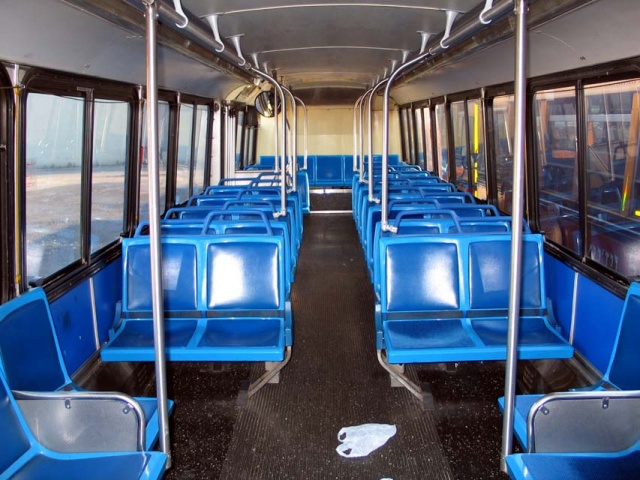Bus Jamming: A commentary on CDTA’s modernization
Perhaps you’ve noticed some changes to Albany’s bus stops in the past few weeks – blue slipcovers over signs informing riders that the stop is slated to be discontinued, or green covers announcing a new one. Effective Sunday, November 13, the Capital District Transportation authority is enacting a massive restructuring to its service in Albany County. Nearly every line is affected by schedule or route changes. Many lower-ridership routes will be consolidated into new ones that the CDTA hopes will be more comprehensive and efficient.

It’s about time. Albany’s bus system is an anachronism, a relic of its days as the United Traction streetcar system. Many routes follow nearly the same path as in the United Traction days. But the last streetcars ran 65 years ago. Albany’s changed. Population and business shifts have led to many city routes becoming virtual lines to nowhere. Meanwhile the most heavily-traveled routes service Crossgates Mall, the University at Albany, and Colonie Centre – places that were literally sand dunes when the trolley wires came down and the city paved over the rails.
Granted, I haven’t been a regular CDTA rider in a few years now – not since 2005, actually, when I took the Central Avenue bus to my job on Wolf Road. My complaints were typical: overcrowded buses, chronic lateness, poor or non-existent service on evenings and weekends. It felt like a punishment to use the CDTA; as soon as I got a car, I swore off the bus. And I wasn’t alone. At that point, CDTA ridership was slipping further every year. Low passenger volumes mean reductions in funding and reductions in service, which leads to even lower ridership, which leads to – a vicious circle.
But driving in Albany is often a headache. Parking, especially in Pine Hills and Center Square, is scarce. Congestion seems to be rising in the city, especially during rush hours. I love public transit in theory, even if in practice, I think it’s best for other people (to paraphrase The Onion). And, to be fair, the CDTA’s been on a modernization kick for the last several years. They’ve modernized their fleet, redrawn the bus routes in Schenectady and Troy, implemented BusPlus express service between Albany and Schenectady, ditched archaic zone fares in favor of a system-wide base fare, and replaced paper transfers with a day pass similar to the MTA’s MetroCard in New York. Updating Albany’s bus routes was the next logical step in an ongoing series of improvements.
On paper, their plan looks good. The highest-volume trunk lines will all see extended service hours on nights and weekends. Buses will also run more frequently on these routes. Neighborhood routes have been reconfigured to increase service area and decrease running times. Most notable among these is addition of a line running the full length of Morton Avenue in the South End, whose residents petitioned the CDTA for service last fall. Overall, the new service map is meant to better reflect the needs of Albany’s population in 2011 after decades of stagnation. That can’t be a bad thing.
But will it work? Like all public transit, the new CDTA route map is a compromise. Some streets lose bus service entirely, and although it looks as if those areas will be few, inevitably some customers won’t be happy about having to walk to a more distant stop. And some Albany residents, I’ll wager, won’t be too thrilled about the introduction of buses to their streets. The obvious measure of the plan’s success will be to see whether overall ridership increases on the system, and it’s on the CDTA to draw riders onto the bus. The Times Union did a fairly thorough job publicizing public hearings about the proposed changes over the summer. Moreover, last Saturday three of Albany’s business improvement districts sponsored free bus rides for college students to entertainment events downtown; it was intended more to encourage students to familiarize themselves with the city’s stores and restaurants, but I’d imagine that the CDTA wouldn’t mind picking up a few riders in the process.
Another Times Union story caught my eye last week. This one wasn’t directly about transit; instead, it discussed the upswing in residential development downtown. City officials and business owners have been talking about reviving downtown for as long as I remember, the main concern being that it’s deserted on nights and weekends aside from an often-troublesome bar scene. Retail: that’s really what Albany wants on Pearl Street and State Street and Broadway. And they figure that the best way to do bring business to the area is to attract people to live off of Pearl Street and State Street and Broadway.
They’ve got a point. People living downtown create a need for businesses near their homes. And the demographic they’re appealing to – young professional singles and couples, mixed with middle-class retirees – is made up of folks with money to spend. Done right, I can picture downtown Albany as a miniature downtown Toronto – a thriving mix of shops, offices, clubs, restaurants and housing. Its actual success depends on a number of factors, of course, but I’d argue that a key component will be the quality of public transportation in the area.
It’s easy to get people onto public transit when they don’t have cars to begin with. One of the undeserved stereotypes of the bus is that it’s the ride “for the poor and very poor alike, as The Simpsons put it so succinctly. This is not at all to belittle the agency’s efforts to improve its coverage in long-underserved sections of the South End – the introduction of Morton Avenue bus service is to be applauded. But it’s quite another thing to convince people to give up their cars to ride the bus. That’s what the city will be asking people to do should their hoped-for repopulation of the city center come to fruition. Downtown Albany is another spot where parking is a massive headache, and I’d imagine parking and transportation issues are going to figure heavily into people’s decisions to move from the suburbs.
Let’s remember that in the 2010 census, Albany saw its first population increase in 60 years, a trend I’d imagine the city would do everything in its power to encourage. More people mean more people to move, and civic and business leaders clearly are aiming for a renaissance here. How well the CDTA can serve this population, how well it can function as a component in attracting residents to Albany, how well they manage to improve and expand their service beyond their restructuring in November – that’s going to be the real test of whether their service changes succeed or fail.
Honestly, I’d like to be one of the people who gives up driving in this city. I sincerely hope they’re up for it.
The full list of changes is available at www.cdta.org, where you can also find full schedules and an Albany County system map.




